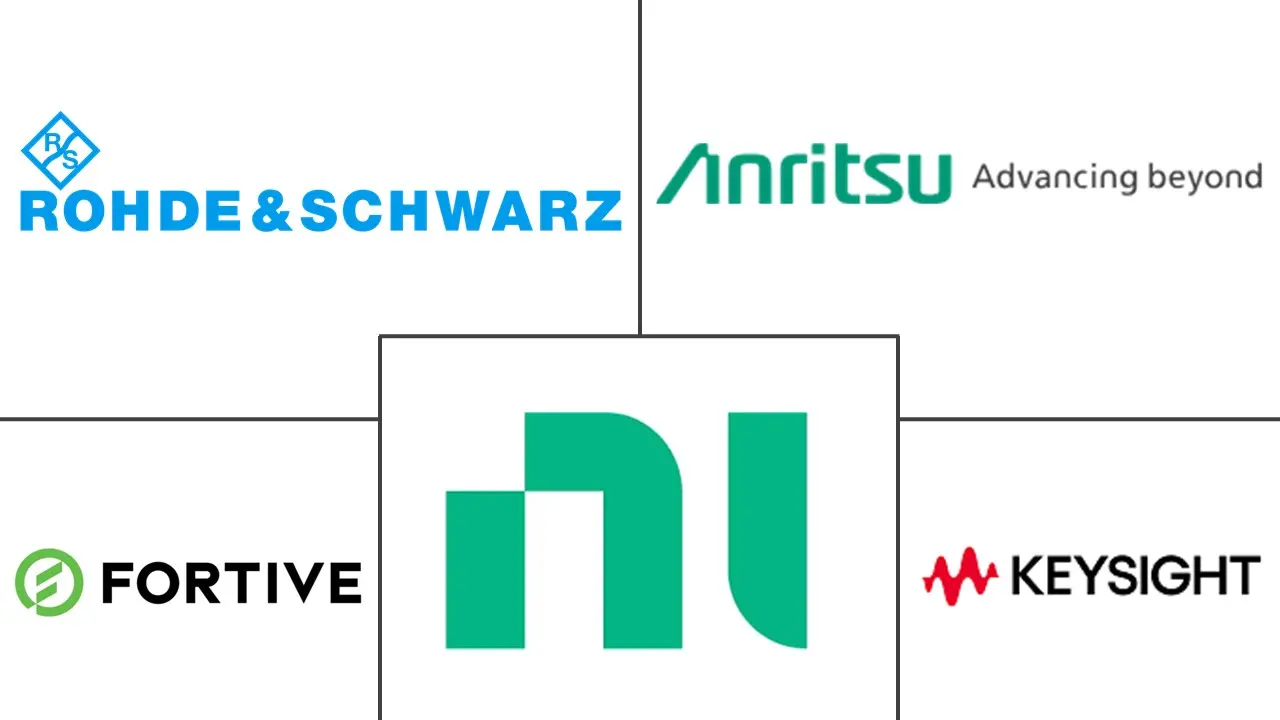Test And Measurement Market Size and Share

Test And Measurement Market Analysis by Mordor Intelligence
The test and measurement market size stood at USD 19.06 billion in 2025 and is forecast to reach USD 23.52 billion in 2030, reflecting a 4.29% CAGR. Engineers are shifting from hardware-centric systems toward software-defined, subscription-based platforms that lighten capital requirements while lifting margins. Modular instrumentation, growing 4.7% annually through 2030, illustrates this transition as design teams seek reconfigurable architecture for complex devices. Asia Pacific leads demand, supported by 5G/6G build-outs and deep electronics manufacturing capacity, while the automotive push for e-mobility and healthcare’s stricter compliance rules fuel segment expansion. Strategic consolidation- exemplified by Emerson’s USD 8.2 billion acquisition of National Instruments - highlights the rising value of software-connected automated test ecosystems.
Key Report Takeaways
- By geography, Asia Pacific commanded 38% of the test and measurement market share in 2024, while the Middle East & Africa region is poised to expand at a 5.4% CAGR to 2030.
- By product category, General Purpose Test Equipment held 66% revenue share in 2024; modular instrumentation is advancing at a 4.7% CAGR through 2030.
- By service type, calibration services accounted for a dominant 72% share of the test and measurement market size in 2024, whereas asset-management and rental services show the fastest 6.3% CAGR to 2030.
- By end-user industry, automotive and transportation led with 31% of the test and measurement market share in 2024; healthcare and medical devices are growing at a 7.2% CAGR through 2030.
- By form factor, benchtop/rack-mounted instruments led with 54.3% revenue share in 2024, while modular/plug-in cards are advancing at an 8.1% CAGR through 2030.
Global Test And Measurement Market Trends and Insights
Drivers Impact Analysis
| Driver | (~) % Impact on CAGR Forecast | Geographic Relevance | Impact Timeline |
|---|---|---|---|
| EV high-voltage testing demand | 1.20% | Europe, North America, China | Medium term (2-4 years) |
| 5G/6G roll-outs expanding RF capacity | 0.90% | Asia Pacific, North America | Short term (≤ 2 years) |
| AI-enabled design-for-test tools | 0.70% | Global, concentrated in North America and East Asia | Medium term (2-4 years) |
| Integrated EV battery cyclers | 0.50% | Europe, North America | Medium term (2-4 years) |
| Tightening EMC/EMI norms for medical electronics | 0.40% | North America, Europe | Short term (≤ 2 years) |
| Transition from CapEx to Test-as-a-Service models | 0.30% | Global, early adoption in North America and Europe | Long term (≥ 4 years) |
| Source: Mordor Intelligence | |||
Automotive e-mobility’s demand for high-voltage, high-bandwidth testing solutions
Electric vehicle platforms operate between 400 V and 800 V and must meet strict safety and efficiency criteria. Tier-one laboratories have installed more than 200 dedicated stands for battery, inverter, and motor validation, enabling microsecond-level measurements across dynamic load and temperature profiles. Integrated power analyzers now sample at 1 MS/s to capture transient spikes that legacy equipment missed, ensuring drivetrain reliability under regenerative-braking regimes.
Rapid 5G/6G roll-outs driving sub-6 GHz and mmWave test capacity in Asia
China’s early-2024 launch of a 6G test satellite set a benchmark for integrated space-ground networks. Operating above 50 GHz, mmWave links suffer high path loss, raising the bar for dynamic-range performance in spectrum analyzers. Demand for over-the-air chambers, phased-array characterization rigs and real-time signal recorders has accelerated as Asian carriers accelerate next-gen deployments.
AI-enabled design-for-test tools shortening semiconductor time-to-market
Machine-learning algorithms embedded in EDA suites trim design-verification cycles by 30–50% and cut power consumption up to 40% on advanced nodes. Scripting assistants generate test sequences, letting engineers focus on architecture choices instead of repetitive runs. Vendors showcase cloud-hosted analytics that flag anomalous signatures, reducing debug effort by up to 70%.
Increasing adoption of integrated EV battery cyclers in Europe
Unified platforms now combine thermal, electrical, and mechanical stress modes, mirroring harsh field profiles. European regulators plan a digital battery passport to trace state-of-health and recycling records, pushing manufacturers to validate lifecycle parameters from formation through end-of-life.[1]Institute of Energy Agency, “Global EV Outlook 2024,” iea.org Domestic sourcing initiatives, triggered by 2025 import tariffs, are reshaping supply chains and boosting local test-equipment uptake.
Restraints Impact Analysis
| Restraint | (~) % Impact on CAGR Forecast | Geographic Relevance | Impact Timeline |
|---|---|---|---|
| Rental shift lowering new instrument ASPs | -0.60% | Asia Pacific (ex-Japan), Latin America, Africa | Medium term (2-4 years) |
| Scarcity of RF talent hampering mmWave adoption | -0.40% | Global, acute in North America and Europe | Long term (≥ 4 years) |
| Fragmented global calibration standards raising compliance costs | -0.30% | Global, highest impact on cross-border operations | Medium term (2-4 years) |
| Trade barriers on precision semiconductors disrupting supply chains | -0.30% | Global, concentrated on China-US routes | Short term (≤ 2 years) |
| Source: Mordor Intelligence | |||
Rental-shift depressing new instrument ASPs in emerging markets
Budget-constrained users favor rental contracts that eliminate up-front capex. Rental firms now bundle calibration and logistics, squeezing OEM margins and prompting vendors to design robust, field-serviceable gear. Hybrid models that mix subscription software with low-cost hardware updates are gaining traction.
Scarcity of RF talent hindering mmWave test adoption
Wireless infrastructure roll-outs require specialists versed in vector error correction, phased-array alignment, and over-the-air metrology. A projected 1.2 million open roles in the U.S. alone risk remaining unfilled, raising project costs and elongating deployment timelines.[2]Wireless Infrastructure Association, “The Skills Gap in Wireless Infrastructure Training and Education,” wia.org Vendor-neutral certification programs and remote-first support tools aim to close the gap.
Segment Analysis
By Product: Modular platforms reshape testing paradigms
The test and measurement market size for general-purpose test equipment remained dominant at 66% revenue share in 2024, underpinning a wide spectrum of R&D and manufacturing tasks. Growth, however, is pivoting toward modular instrumentation, which is expanding at a 4.7% CAGR through 2030 as engineers prioritize scalability and rapid reconfiguration. Design teams integrate PXI chassis with FPGA-based cards for mixed-signal consolidation, reducing rack footprints while preserving channel density.
Demand for RF and microwave test systems is also accelerating on the back of 5G handset launches and early 6G prototypes. Spectrum-analysis sensitivity, previously capped by thermal noise floors, now benefits from upgraded ADC resolution and low-phase-noise synthesizers. Mechanical test equipment, though essential for materials and structural validation, experiences slower replacement cycles because heavy frameworks remain serviceable for decades. Automated test equipment bridges high-volume semiconductor lines, combining parametric measurements with AI-driven outlier detection to keep yields above 99.5%.
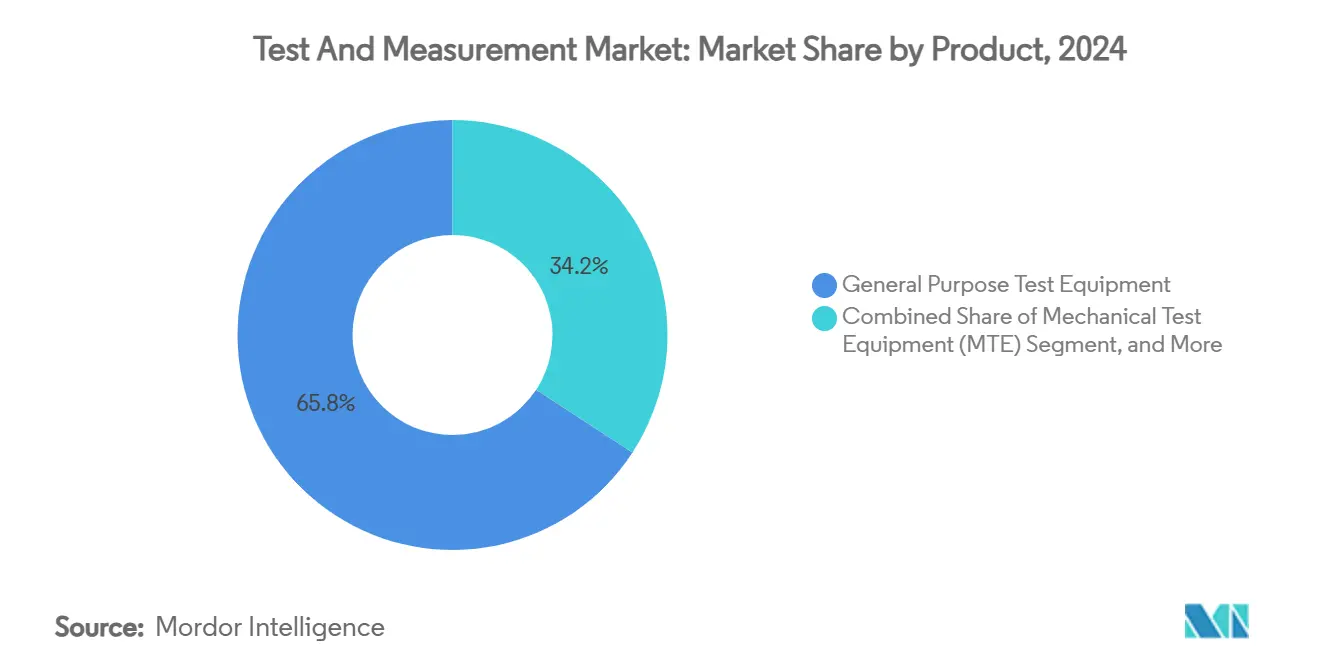
Note: Segment shares of all individual segments available upon report purchase
By Service Type: Rental models disrupt traditional ownership
Operational expenditure strategies are reshaping how firms procure measurement capability. Asset management and rental services, the fastest-growing service subset at a 6.3% CAGR, let manufacturers preserve cash while ensuring access to the latest platforms. Subscription bundles now include remote calibration, predictive maintenance, and compliance documentation. Nonetheless, calibration services kept a commanding 72% share of the test and measurement market size in 2024, reflecting the statutory need for traceable accuracy in semiconductor lithography, aerospace avionic,s and medical diagnostics.
Digital workflows are streamlining the calibration cycle. QR-coded asset tracking links each instrument to its service record, while automated fixtures reduce turnaround times by up to 25%. Remote firmware updates close metrological gaps between scheduled visits. Training and consulting services round out the portfolio, offering on-premises workshops that bridge skills gaps in power integrity, EMC, and safety-critical software validation.
By End-User Industry: Healthcare emerges as growth engine
Healthcare and medical devices posted a 7.2% CAGR, the fastest expansion among verticals, as regulators tightened electromagnetic compatibility and software validation norms. Mobile-connected ventilators, insulin pumps and imaging probes must pass exhaustive RF coexistence and cybersecurity checks before clearance. Partnerships between wireless test suppliers and med-tech firms have moved verification into early design phases, mitigating schedule risks.
Automotive and transportation, with 31% of the test and measurement market share in 2024, continued to invest in high-voltage battery cyclers, inverter durability rigs, and ADAS radar targets. Semiconductor fabrication remained a cornerstone, demanding parametric and functional testers that can handle wafer-level stress at 3 nm nodes. Aerospace and defense customers required ruggedized instruments certified to MIL-STD-461 for electromagnetic emissions. Education and research laboratories favored versatile, low-cost platforms to support mixed curricula across robotics, photonics, and materials science.
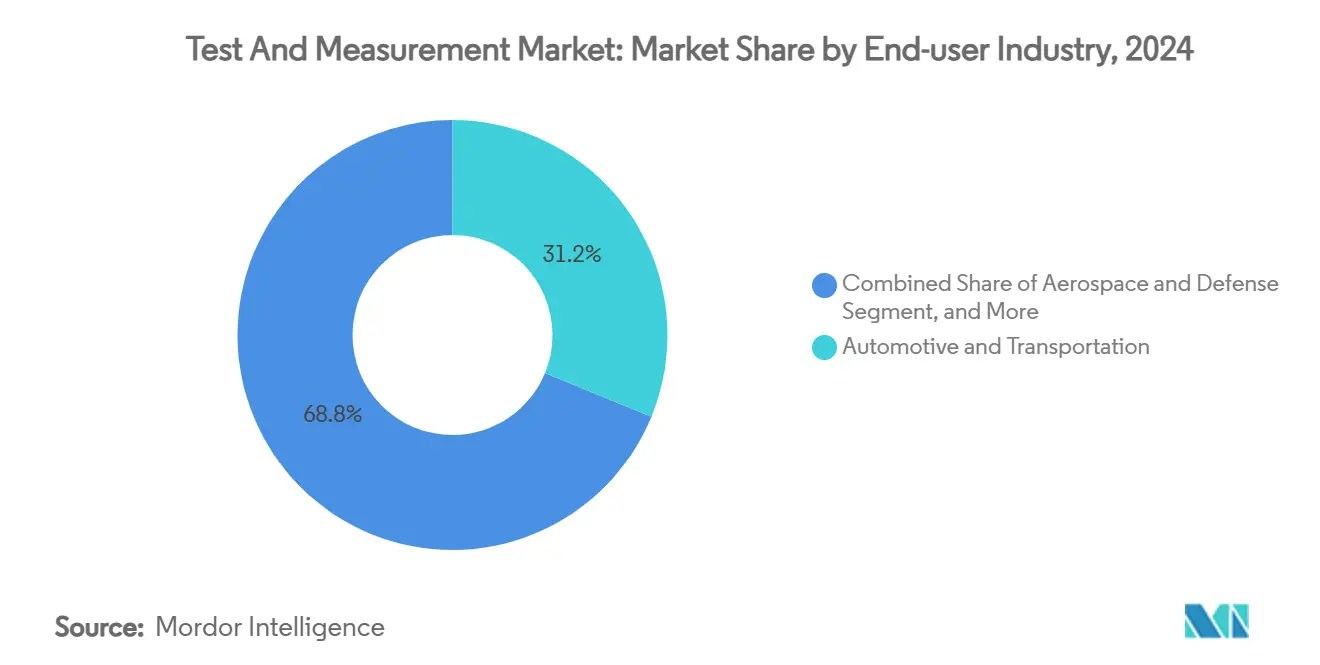
Note: Segment shares of all individual segments available upon report purchase
By Form Factor: Modular Cards Drive Testing Evolution
Benchtop / rack-mounted instruments held 54.3% of the test and measurement market share in 2024, underscoring their continued importance where highest stability, multichannel I/O and comprehensive analysis functions are required. These systems remain central to lab and production lines, supporting complex mixed-signal characterisation, high-power measurements and compliance verification across industries from automotive powertrains to aerospace avionics. Yet momentum is shifting toward reconfigurable architectures, with modular / plug-in cards-built on PXI, AXIe and USB standards-forecast to expand at an 8.1% CAGR between 2025 and 2030, almost twice the overall market pace. Engineers value the smaller footprint, lower incremental cost and software-defined flexibility that let them redeploy slots as device specifications change, trimming both set-up time and total cost of ownership.
The rise of modular cards is reshaping test-system design philosophies. Leading suppliers are investing in FPGA-accelerated modules, high-speed backplanes and unified software stacks that coordinate timing, triggering and data exchange across mixed-vendor chassis. Automotive, aerospace and telecommunications labs increasingly integrate modular platforms to scale channel counts for battery cycling, radar target simulation and massive-MIMO beam-forming without replacing entire racks, safeguarding capital budgets while embracing new standards. Handheld / portable instruments continue to address field diagnostics where battery power and on-site agility matter, whereas desktop / PC-based rigs serve cost-sensitive education and R&D programs that prioritise software versatility over hardware density. As modular adoption broadens, vendors that blend hot-swappable cards with unified management software are best positioned to capture incremental spend within the test and measurement market size across the forecast horizon.
Geography Analysis
Asia Pacific accounted for 38% of global revenue in 2024, reflecting deep electronics manufacturing ecosystems and aggressive 5G/6G infrastructure spend. China’s field test network demonstrated a 10-fold performance gain, driving orders for multi-port vector network analyzers and OTA chambers. Taiwan and South Korea’s foundries imported high-density probe stations to validate 2.5D packages for AI accelerators.
North America, the second-largest region, leveraged strong aerospace, defense, and medical sectors and strict FDA oversight requiring IEC 60601-based EMC verification. Investment in AI and cloud testing platforms accelerated after the 2024 infrastructure stimulus. Private-equity transactions in fiber, tower, and data-center assets lifted demand for field-portable optical-time-domain reflectometers and high-speed BERTs.
The Middle East and Africa displayed the fastest CAGR at 5.4% to 2030 as telecom carriers upgraded backhaul links and industrial operators adopted ISO-certified quality frameworks. Regional energy initiatives around hydrogen and solar projects also required precision electrical metering. Europe preserved its lead in EV powertrain and battery-testing competence, supported by sustainability regulations mandating recycling validation. South America’s build-out of smart-grid and broadband capacity stimulated incremental orders for power analyzers and RF interference analyzers.
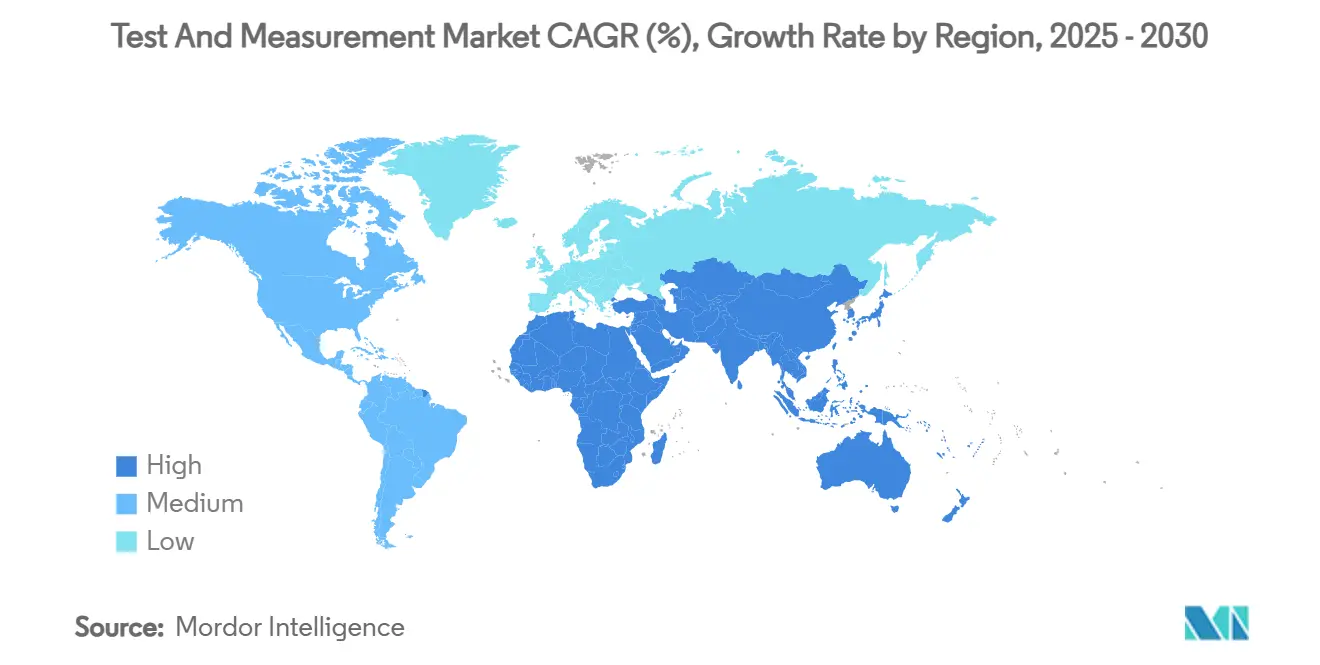
Competitive Landscape
The five leading vendors-Keysight Technologies, Rohde & Schwarz, Emerson’s NI, Fortive (comprising Tektronix and Fluke), and Anritsu-controlled roughly two-thirds of 2024 revenue. Emerson’s integration of NI created a dedicated Test & Measurement group aiming for 4-7% organic growth by leveraging NI’s software-centric portfolio.[3]Emerson Electric, “Emerson Completes Acquisition of NI,” emerson.com Keysight expanded its Test-as-a-Service laboratories in Germany and Malaysia, bundling turnkey EMC certification into multi-year service contracts.
Rohde & Schwarz showcased AI-powered scripting assistants that auto-generate signaling sequences, simplifying handset testing workflows. Fortive invested in cloud-connected oscilloscope platforms that enable real-time collaboration between distributed engineering teams. Niche specialists, from battery cycler developers to photonics metrology houses, exploit their agility to serve emerging sub-segments ahead of larger rivals. Competitive advantage is migrating from stand-alone hardware performance to integrated software, analytics, and ecosystem connectivity that foster recurring revenue.
Test And Measurement Industry Leaders
-
Fortive Corporation
-
Keysight Technologies, Inc.
-
Rohde & Schwarz GmbH & Co. KG
-
National Instruments Corporation
-
Anritsu Corporation
- *Disclaimer: Major Players sorted in no particular order
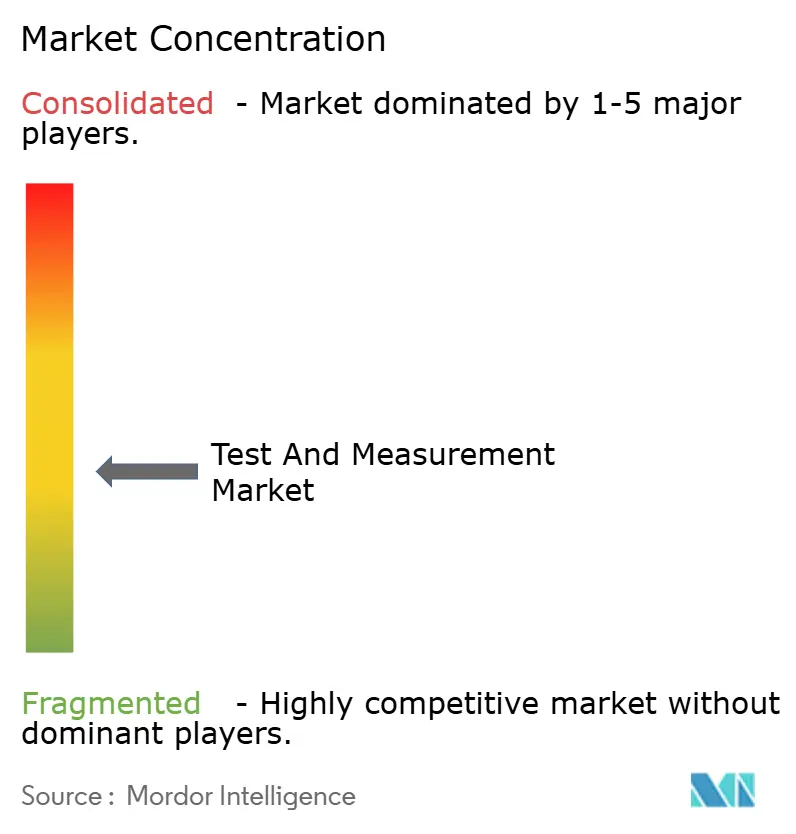
Recent Industry Developments
- May 2025: Keysight Technologies reported Q2 2025 revenue of USD 1.31 billion and raised full-year guidance as 5G-Advanced and early 6G demand recovered.
- April 2025: Delta Electronics unveiled a megawatt charging system for heavy-duty EVs, underscoring power-testing requirements at MCS levels.
- March 2025: Keysight launched oscilloscopes targeting 1.6 Tb optical transceiver validation in AI data centers.
- February 2025: Rohde & Schwarz debuted the CMX500 5G one-box tester and upgraded small-cell vector testers at MWC 2025.
Global Test And Measurement Market Report Scope
Test and measurement equipment plays a crucial role in analyzing, validating, and verifying measurements for both electronic and mechanical systems. These instruments generate signals and capture responses from the electronic devices being tested. Their primary purpose is to assess the efficiency of operational processes, helping manufacturers monitor and enhance the quality, safety, and productivity of their products.
The market is defined by the revenue accrued from offering test and measurement systems. The study tracks the market across several major segments. All the market data and projections are adjusted to reflect the impact of current geopolitical scenarios and broader macroeconomic factors on the market.
The test and measurement market is segmented by type (oscilloscopes, digital multimeters (DMMs), source measurement units (SMUs), spectrum analyzers, arbitrary waveform generators (AWGs), power supply, RF test equipment, data acquisition (DAQ) system, others), by end-user (communications, semiconductors and computing, advanced research, consumer electronics, automotive, industrial, aerospace and defense, others), by geography (North America, Europe, Asia Pacific, Latin America, and Middle East and Africa). The market sizes and forecasts are provided in terms of value in USD for all the above segments.
| General Purpose Test Equipment (GPTE) |
| Mechanical Test Equipment (MTE) |
| Modular Instrumentation (PXI, VXI, AXIe) |
| RF/Microwave Test Equipment |
| Automated Test Equipment (ATE) |
| Specialized Instruments (Battery, Environmental, Signal Integrity) |
| Calibration Services |
| Repair/After-Sales Services |
| Asset Management and Rental Services |
| Training and Consulting |
| Automotive and Transportation |
| Aerospace and Defense |
| Telecommunications and IT |
| Semiconductor and Electronics Manufacturing |
| Healthcare and Medical Devices |
| Education and Research Laboratories |
| Industrial Automation and Energy |
| Benchtop/Rack-Mounted Instruments |
| Portable/Handheld Instruments |
| Modular/Plug-in Cards (USB, PCIe) |
| Embedded/In-System Test Modules |
| North America | United States |
| Canada | |
| Mexico | |
| Europe | Germany |
| United Kingdom | |
| France | |
| Italy | |
| Spain | |
| Nordics (Denmark, Sweden, Norway, Finland) | |
| Rest of Europe | |
| Asia-Pacific | China |
| Japan | |
| South Korea | |
| India | |
| Southeast Asia | |
| Australia | |
| Rest of Asia-Pacific | |
| South America | Brazil |
| Argentina | |
| Rest of South America | |
| Middle East | Gulf Cooperation Council Countries |
| Turkey | |
| Rest of Middle East | |
| Africa | South Africa |
| Nigeria | |
| Rest of Africa |
| By Product | General Purpose Test Equipment (GPTE) | |
| Mechanical Test Equipment (MTE) | ||
| Modular Instrumentation (PXI, VXI, AXIe) | ||
| RF/Microwave Test Equipment | ||
| Automated Test Equipment (ATE) | ||
| Specialized Instruments (Battery, Environmental, Signal Integrity) | ||
| By Service Type | Calibration Services | |
| Repair/After-Sales Services | ||
| Asset Management and Rental Services | ||
| Training and Consulting | ||
| By End-user Industry | Automotive and Transportation | |
| Aerospace and Defense | ||
| Telecommunications and IT | ||
| Semiconductor and Electronics Manufacturing | ||
| Healthcare and Medical Devices | ||
| Education and Research Laboratories | ||
| Industrial Automation and Energy | ||
| By Form Factor | Benchtop/Rack-Mounted Instruments | |
| Portable/Handheld Instruments | ||
| Modular/Plug-in Cards (USB, PCIe) | ||
| Embedded/In-System Test Modules | ||
| By Geography | North America | United States |
| Canada | ||
| Mexico | ||
| Europe | Germany | |
| United Kingdom | ||
| France | ||
| Italy | ||
| Spain | ||
| Nordics (Denmark, Sweden, Norway, Finland) | ||
| Rest of Europe | ||
| Asia-Pacific | China | |
| Japan | ||
| South Korea | ||
| India | ||
| Southeast Asia | ||
| Australia | ||
| Rest of Asia-Pacific | ||
| South America | Brazil | |
| Argentina | ||
| Rest of South America | ||
| Middle East | Gulf Cooperation Council Countries | |
| Turkey | ||
| Rest of Middle East | ||
| Africa | South Africa | |
| Nigeria | ||
| Rest of Africa | ||
Key Questions Answered in the Report
What is the current value of the test and measurement market?
The test and measurement market size reached USD 19.06 billion in 2025 and is projected to rise to USD 23.52 billion by 2030.
Which region leads global demand?
Asia Pacific leads with 38% revenue share, driven by large-scale electronics manufacturing and accelerated 5G/6G deployments.
Which product category holds the largest share?
General Purpose Test Equipment maintains a 66% share, acting as the backbone for cross-industry test operations.
Why is healthcare the fastest-growing end-user segment?
Stricter electromagnetic-compatibility rules and the spread of connected medical devices are pushing healthcare test spending at a 7.2% CAGR.
Page last updated on:
